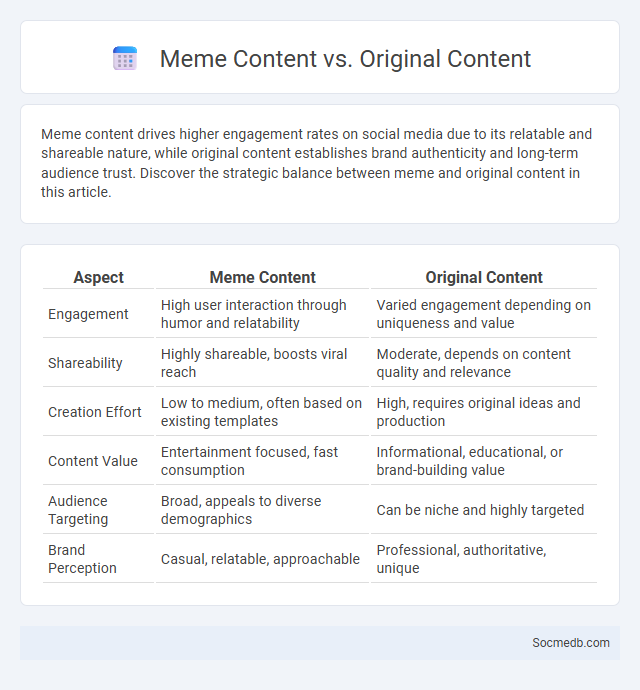
Photo illustration: Meme Content vs Original Content
Meme content drives higher engagement rates on social media due to its relatable and shareable nature, while original content establishes brand authenticity and long-term audience trust. Discover the strategic balance between meme and original content in this article.
Table of Comparison
| Aspect | Meme Content | Original Content |
|---|---|---|
| Engagement | High user interaction through humor and relatability | Varied engagement depending on uniqueness and value |
| Shareability | Highly shareable, boosts viral reach | Moderate, depends on content quality and relevance |
| Creation Effort | Low to medium, often based on existing templates | High, requires original ideas and production |
| Content Value | Entertainment focused, fast consumption | Informational, educational, or brand-building value |
| Audience Targeting | Broad, appeals to diverse demographics | Can be niche and highly targeted |
| Brand Perception | Casual, relatable, approachable | Professional, authoritative, unique |
Understanding Meme Content: Definition and Characteristics
Meme content on social media consists of humorous or relatable images, videos, or text that spread rapidly among users, often reflecting cultural trends or social commentary. These memes typically feature recognizable formats, catchy captions, and a shareable nature that enhances their viral potential. Understanding meme characteristics involves analyzing their visual style, humor, context relevance, and the adaptability that allows them to evolve with audience participation.
Defining Original Content: Creativity and Uniqueness
Original content on social media is defined by its creativity and uniqueness, showcasing fresh ideas that stand out amid vast online information. Your ability to craft distinctive posts, images, or videos not only attracts and retains followers but also establishes a strong personal or brand identity. Emphasizing originality ensures engagement through authentic storytelling and innovative presentation styles that resonate with target audiences.
What Makes Content Viral? Key Viral Elements
Content becomes viral when it taps into emotional triggers such as humor, surprise, or relatability, prompting users to share quickly with their networks. High-quality visuals, clear messaging, and timely relevance amplify engagement, boosting your content's visibility across platforms. Your content's potential to inspire interaction and convey authenticity directly influences its viral reach and success.
Meme Content vs Original Content: Key Differences
Meme content thrives on humor, relatability, and viral potential, often leveraging popular culture to engage audiences quickly, while original content showcases unique creativity and brand identity, building deeper connections with followers. Memes are easily shareable and generate high engagement through instant recognition, whereas original content requires more effort to develop but fosters long-term loyalty and thought leadership. You should balance both types strategically to maximize reach and authenticity on your social media platforms.
The Influence of Virality on Content Creation
Virality significantly shapes content creation by driving creators to produce engaging, shareable material tailored to algorithm preferences on platforms like TikTok and Instagram. Understanding patterns in viral content, such as trending hashtags and user interaction metrics, enables marketers and influencers to optimize reach and audience engagement effectively. This emphasis on viral potential often accelerates content innovation, blending creativity with data-driven strategies to maximize visibility.
Audience Engagement: Which Type Wins?
Visual content such as images and videos consistently outperforms text-only posts in audience engagement across major social media platforms like Instagram, Facebook, and TikTok, driving higher likes, shares, and comments. Interactive content including polls, quizzes, and live streams further boosts engagement rates by fostering active participation and real-time interaction. User-generated content also significantly increases trust and loyalty, as followers are more likely to engage with authentic and relatable posts from their peers.
SEO Impact: Meme, Original, and Viral Content
Meme content often boosts social media engagement by increasing shareability and user interaction, which positively influences SEO rankings through higher traffic and backlink generation. Original content establishes brand authority and uniqueness, enhancing search engine trust and improving keyword relevance for better organic visibility. Viral content amplifies exposure rapidly, driving significant referral traffic and social signals that contribute to enhanced domain authority and search engine performance.
Monetization Potential: Comparing Content Types
Video content on social media platforms typically yields higher monetization potential due to greater viewer engagement and ad revenue opportunities. Influencers leveraging short-form videos such as reels or TikToks often earn more compared to static images or text posts because of increased algorithmic promotion and brand partnerships. Your strategy should prioritize creating high-quality video content to maximize earnings through sponsorships, affiliate marketing, and platform-specific monetization features.
Best Practices for Balancing Content Types
Balancing content types on social media involves strategically mixing promotional posts, educational materials, and engaging user-generated content to maintain audience interest and trust. Utilizing data analytics to track engagement rates for various content formats ensures optimized posting schedules and enhanced reach. Incorporating a consistent brand voice while adapting content style to platform-specific trends maximizes relevance and follower interaction.
Future Trends: The Evolution of Digital Content
Social media is rapidly evolving, with future trends highlighting immersive technologies like augmented reality (AR) and virtual reality (VR) transforming digital content into interactive experiences. AI-driven personalization will tailor your feeds, delivering hyper-relevant content that enhances engagement and user satisfaction. Short-form videos and ephemeral content continue to dominate, shaping the way brands and creators connect with audiences on platforms such as TikTok, Instagram, and emerging decentralized social networks.
 socmedb.com
socmedb.com